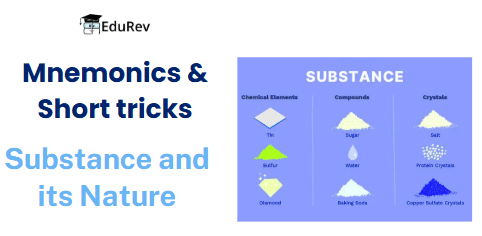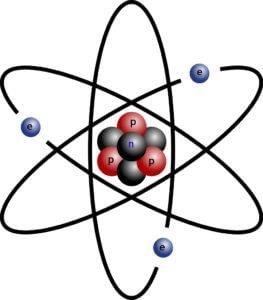UPSC Exam > UPSC Notes > Science & Technology for UPSC CSE > Mnemonics: Substance and its Nature
Mnemonics: Substance and its Nature | Science & Technology for UPSC CSE PDF Download
This document will help you remember important information about the substances and their nature in a fun and easy way. Inside, you'll find mnemonics—memory tricks—that simplify the understanding of cellular components, their composition, and their functions.

Whether you're studying for an exam, preparing for a quiz, or exploring the fundamental nature of substances within a cell, these mnemonics will serve as valuable memory aids. Use them alongside your regular studies to strengthen your understanding and enhance recall.
Happy mnemonic learning!
1. The Atomic Theory
Mnemonic: DJ JEN-EW" (Like a DJ named Jen saying "ew!" at bad music)
Mnemonic Explanation:
- D: Democritus (460-370 BC)
- J: John Dalton (1766-1844)
- J: J.J. Thomson (1856-1940)
- E: Ernest Rutherford (1871-1937)
- N: Niels Bohr (1885-1962)
- E: Erwin Schrödinger (1887-1961)
- W: Werner Heisenberg (1901-1976)
2. Types of Chemical Reactions
Mnemonic: Charlie Drinks Double Delicious Coffee."

Mnemonic Explanation:
- Charlie: Combination Reaction
- Drinks: Decomposition Reaction
- Double: Displacement Reaction
- Delicious: Double Displacement Reaction
- Coffee: Combustion Reaction
The document Mnemonics: Substance and its Nature | Science & Technology for UPSC CSE is a part of the UPSC Course Science & Technology for UPSC CSE.
All you need of UPSC at this link: UPSC
|
90 videos|491 docs|209 tests
|
FAQs on Mnemonics: Substance and its Nature - Science & Technology for UPSC CSE
| 1. What is the Atomic Theory and who proposed it? |  |
Ans. The Atomic Theory is a scientific theory that states that matter is composed of discrete units called atoms. The concept was first proposed by ancient Greek philosophers, but it was John Dalton in the early 19th century who formulated a modern version of the theory. Dalton's theory included the ideas that atoms are indivisible particles, that all atoms of a given element are identical, and that chemical reactions involve the rearrangement of atoms.
| 2. What are the main types of chemical reactions? |  |
Ans. The main types of chemical reactions include synthesis (combination) reactions, decomposition reactions, single replacement (displacement) reactions, double replacement reactions, and combustion reactions. Each type has distinct characteristics and involves different processes, such as combining substances to form a new compound or breaking down a compound into simpler substances.
| 3. How can mnemonics help in understanding chemical reactions? |  |
Ans. Mnemonics are memory aids that can help students remember the types of chemical reactions and their characteristics. For example, a simple phrase or acronym can be created to represent each type of reaction, making it easier to recall them during studies or exams. This technique enhances memory retention and aids in quick retrieval of information.
| 4. What role do atoms play in chemical reactions? |  |
Ans. Atoms are the fundamental building blocks of matter and play a crucial role in chemical reactions. During these reactions, atoms may rearrange to form new compounds, bond with other atoms, or break apart. The way atoms interact and combine determines the outcome of the chemical reaction, including the formation of products and the release or absorption of energy.
| 5. Why is the Atomic Theory important in chemistry? |  |
Ans. The Atomic Theory is essential in chemistry because it provides a framework for understanding the composition and behavior of matter. It allows scientists to explain chemical reactions, predict the outcomes of reactions, and develop new materials. The theory has also paved the way for advancements in various fields such as pharmacology, materials science, and environmental chemistry.
Related Searches





















